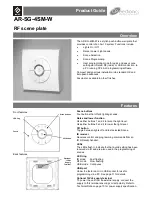
8
•
C Language Example:
1102tc.c
File Location:
a:\c_ex\1102\1102tc.c
(on SCXI Applications Examples diskette)
Thermocouple Overview
A thermocouple is created whenever two dissimilar metals touch and the contact point produces a small open-
circuit voltage that varies as a function of temperature. This thermoelectric voltage is known as the Seebeck
voltage and is nonlinear with respect to temperature. However, for very small changes in temperature, the
voltage is approximately linear and can be expressed in the following equation:
∆
V = S
∆
T
where
∆
V is the change in voltage, S is the Seebeck coefficient, and
∆
T is the change in temperature.
S varies with changes in temperature, causing the output voltages of thermocouples to be nonlinear over their
operating ranges.
Several types of thermocouples are generally available; these thermocouples are designated by capital letters
that indicate their composition according to American National Standards Institute (ANSI) conversions. For
example, the J-type thermocouple included in this package consists of one iron wire and one constantan
(a copper-nickel alloy) wire.
Signal Conditioning Considerations
When using thermocouples, you should be aware of several measurement issues such as the following:
•
Cold-junction compensation
•
Nonlinear data
•
Low-voltage signals
•
Noisy signals
Cold-Junction Compensation
When you connect a thermocouple wire to your terminal block, you create one or two additional
thermocouples where the sensor wire contacts the terminal. You must account for the voltage generated at this
junction, called the cold junction. Use the following equation:
V
TC
(T
TC
) = V
MEAS
+ V
TC
(T
cjc
)
where V
MEAS
is the thermocouple voltage measured by your data acquisition (DAQ) system, V
TC
(T
cjc
) is the
cold-junction voltage at the terminal block, and V
TC
(T
TC
) is the compensated thermocouple voltage that you
can scale to temperature units.
First, measure the temperature of the cold junction, T
cjc
, and use this reading to calculate V
TC
(T
cjc
). The
SCXI terminal blocks include a special cold-junction temperature sensor for this purpose. The first thing that
your temperature measurement program does is take a reading of the cold-junction temperature sensor. If you
are using the SCXI-1300, this sensor is an IC temperature sensor, which outputs 10 mV/˚C.
The SCXI-1303 isothermal terminal block includes a high-precision thermistor temperature sensor that outputs
1.91 V at 0˚ C to 0.58 V at 55˚ C. Because the thermistor output is nonlinear, you must use a thermistor
linearizing function to convert the measured voltage to temperature. National Instruments software supplies
you with a function to linearize thermistor outputs.
After you determine the cold-junction temperature, your software must convert this temperature into the
voltage for the appropriate thermocouple type. National Instruments conversion functions include thermocouple
Summary of Contents for SCXI SCXI-1102
Page 10: ......




























